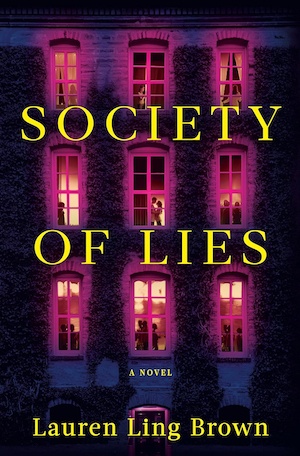
Although author Lauren Ling Brown is at pains to make clear that her new thriller Society of Lies doesn’t reflect either real characters or social groups at Princeton University, where she did her undergraduate work, she does a nice job recreating much of the local geography and milieu. Still, you’re forced to wonder to what extent her college experience in Connecticut is reflected in this work.
Our protagonist Maya is visiting the campus a decade after her graduation to witness the graduation of her younger sister, Naomi. She’s been Naomi’s protector ever since their parents died years earlier. Officially, Naomi’s guardian was Margaret St Clair up until she turned 18, but Maya’s life course has been planned around what she can do to ensure Naomi’s future.
Returning to Princeton triggers waves of memories, especially those surrounding the eating club, Sterling, where both she and Naomi were members. Eating clubs – combination dining hall and social club – are a nearly 150-year-old tradition at Princeton. The competition to get into the most selective clubs is fierce, and they have both men and women members.
Brown’s fictional Sterling Club is the elite of the elite and has a corrupt secret society at its heart. Like the real-life eating clubs, it maintains and nurtures strong ties with its alumni members. The ultra-successful alumni help new graduates find internships, obtain jobs and in many other ways deploy their connections to ease life’s path.
When Maya was an undergraduate, she saw that becoming a member of Sterling would be a tangible way to help Naomi. Maya’s friend, Daisy, was a Sterling member and helped her meet the right people, Cecily and Kai, who could assure she would be asked to join. The four women have remained extraordinarily close friends in the years since. It was not just the good times that kept them together; sad to say, they were involved in the death of their friend Lila a decade before. They’d known Lila was at risk and hadn’t protected her, something Maya still feels guilty about.
With all the good things membership in a club like Sterling can offer, there’s always a downside. It’s tempting for members to use their connections to cut corners, to leverage the influence of the wealthy alumni for selfish, even illegitimate ends – risky investments, sketchy admissions, payoffs to decision-makers. Lila had been on a mission to expose that, as well as the role of one particular Sterling alum, economics professor Matthew DuPont, in the misdeeds. The four friends share in that guilty secret.
This is all brought back to Maya in the story’s first chapter when, on the eve of graduation, Naomi is found drowned. The story timeline ping-pongs between a grieving Maya determined to find out what really happened to her sister, Naomi’s last few months on campus, and Maya’s uni experiences a decade earlier. Although each short chapter is clearly labelled, the similarities between the sisters’ experiences with the Sterling social scene, their boyfriend troubles, the frequent alcohol and drug hazes, and their dislike of Professor DuPont can make it hard to keep story events straight. Chapter headers, like ‘Naomi, March 2023, two months before her death,’ are life-savers.
With Naomi’s death from a multiple drug overdose and Maya’s refusal to accept the too-easy ‘suicide’ label, I had a disquieting association with real life events in Princeton, where I have lived for decades. Almost two years ago now, a student disappeared after an evening working at one of the eating clubs. Her roommates last saw her after midnight brushing her teeth. In the morning, she was gone. Princeton is a small campus, yet her body wasn’t found for five days. The medical examiner’s conclusion of suicide was arrived at, in part, I believe, because no logical alternative was discovered. In the fictional Naomi’s case, the perpetrators had ample reason to hide the truth.
The extent of drinking and drug use – prescription and otherwise – may be realistic. But when the characters’ resulting confusion and flawed memories repeatedly lead to red herrings in the story, it can become tiresome. Doctored cocktails and water bottles are a theme here.
Although Brown has some surprises in store, she plays fair. She provides the clues needed to back up where the story ends up. Her writing style is promising, but in this book the prose is too wordy in places and slows things down. It isn’t necessary to describe characters’ emotions over and over. Their reactions are quite understandable. Everyone’s had a friend who was stuck in a romantic rut, like Naomi is with Liam, her boyfriend, ex-boyfriend, boyfriend again, ex-again Liam, and most have eventually lost patience with those friends.
For a different sort of mystery in academia, see This is How We End Things by RJ Jacobs.
Bantam
Print/Kindle
£23.17
CFL Rating: 3 Stars








